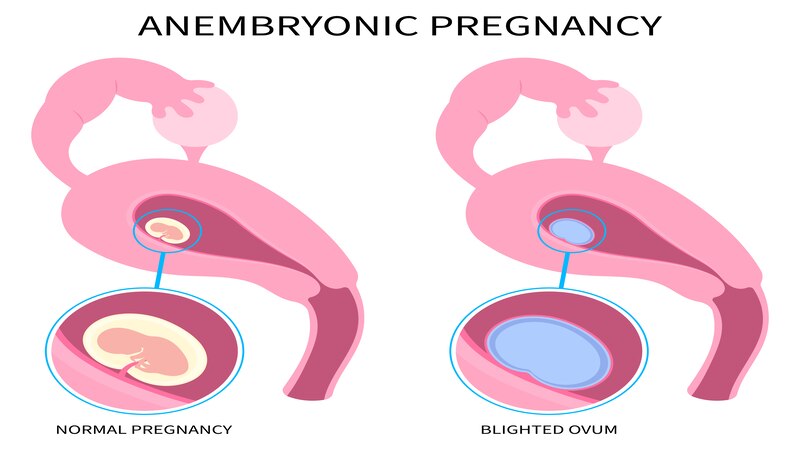 Witnessing the two positive lines on a pregnancy test is enough to send a couple on cloud nine. Many couples eagerly wait to hear the good news and the first ultrasound scan. Of course, sometimes it can be heart-wrenching to know that the pregnancy is not viable. Early pregnancy loss is quite common these days, and one of the most common reasons is a Blighted Ovum.
Witnessing the two positive lines on a pregnancy test is enough to send a couple on cloud nine. Many couples eagerly wait to hear the good news and the first ultrasound scan. Of course, sometimes it can be heart-wrenching to know that the pregnancy is not viable. Early pregnancy loss is quite common these days, and one of the most common reasons is a Blighted Ovum.
If you have been diagnosed with a blighted ovum, and you return home with an ultrasound picture of an empty sac, then you probably would need some time to process this loss. Your mind would have hundreds of questions about the impact on your future pregnancies. Here is everything you would need to know about the causes, symptoms and management of a blighted ovum.
What Is A Blighted Ovum?

A blighted ovum, also called an anembryonic pregnancy, is a condition when a fertilized egg implants itself into the uterus, but does not grow into an embryo [1]. Here, the formed gestational sac grows, but there is no embryo inside. Even though the embryo is absent, the body continues to show early pregnancy symptoms and even a positive pregnancy test until miscarriage happens. This condition is one of the most common causes of early pregnancy loss or miscarriage and accounts for about 50% of all first trimester pregnancy losses [2].
When Does A Blighted Ovum Happen?
Typically, a blighted ovum happens early in the first trimester of pregnancy. Sometimes, it happens so early that a woman does not even know that she is pregnant. During the various stages of fetal development, once an egg is fertilized, it grows into a blastocyst. Usually, around four weeks of pregnancy, this blastocyst implants in the uterine lining and further develops into an embryo [3]. In a blighted ovum, the gestational sac holding the embryo continues to grow with no embryo inside.
What Are The Causes Of Blighted Ovum?

Most often, a blighted ovum occurs as a result of a genetic or chromosomal abnormality during the process of cell division. Major contributing factors are:
- Chromosomal abnormalities: Sometimes errors happen in the chromosomes during fertilization, causing problems in the development of an embryo [4].
- Uterine abnormalities: Uterine malformations like a bicornuate or a septate uterus can lead to an anembryonic pregnancy [5].
- Advanced maternal age: Aging often leads to chromosomal anomalies, increasing the chances of early pregnancy loss [6].
Symptoms Of A Blighted Ovum

A blighted ovum happens so early in the pregnancy that many women don’t notice it until miscarriage happens [7]. Some women start noticing signs of an early pregnancy, like morning sickness, fatigue and breast tenderness. Many women get a positive pregnancy test when they miss their period.
The above pregnancy symptoms happen due to the hCG hormone. But, when the embryo fails to grow, the levels of hCG fall, leading to the disappearance of pregnancy symptoms [8].
This is when signs of miscarriage start showing up, such as:
- Heavy bleeding is similar to that of menstrual bleeding. There may be the presence of small clots.
- Mild to moderate abdominal cramps
- The decline in pregnancy symptoms due to falling hCG levels.
How To Diagnose Blighted Ovum?
The only way to diagnose a blighted ovum is by using a transvaginal ultrasound, which usually happens around the 7th to 9th week of pregnancy [9]. This is the period when a normal pregnancy starts showing the presence of an embryo. But, in the case of a blighted ovum, the ultrasound picture shows an empty gestational sac, like an empty bubble.
Some doctors recommend serial measurement of the hCG hormone. In an anembryonic pregnancy, the levels of hCG often plateau or rise quite slowly as compared to a normal pregnancy.
What Are The Treatment Options For Blighted Ovum

The treatment of a blighted ovum usually depends on the general health of the woman and how far along in her pregnancy she is. Common treatment options are:
- Expectant Management: Many doctors recommend waiting for a few days after the diagnosis of a blighted ovum is confirmed. Usually, the body expels the uterine contents on its own, naturally.
- Medical Management: Sometimes, certain medications are prescribed that aid in the expulsion of the uterine contents [10]. This is given when the body does not expel the contents naturally.
- Surgical Management: This involves dilatation and curettage (D&C) [11]. Here, using some instruments the uterine lining is scraped off to remove the empty sac. This line of treatment is usually the last resort.
How Long Does It Take To Recover From A Blighted Ovum?

The recovery time after a blighted ovum is treated usually depends on person to person and on the type of treatment used. In the case of a natural miscarriage, recovery generally takes a week or two, up to one month. Cramping usually lasts for about a week, but the bleeding may last longer.
Recovery after a medical management usually takes a few weeks and requires watchful monitoring to ensure that the miscarriage is complete.
Recovery from a D&C usually takes a few weeks and there can be fatigue, cramping and occasional spotting for some time.
Usually, doctors advise resting for a few weeks and avoiding strenuous exercises. Most of the women get their period, four to six weeks after an anembryonic pregnancy.
Can Blighted Ovum Be Prevented?

A blighted ovum cannot be prevented, as most often it occurs as a result of chromosomal abnormalities. Sometimes, people go for genetic testing of the products of conception to understand the reason behind the miscarriage. Doctors advise waiting for at least 1-3 regular menstrual cycles before trying to conceive after the miscarriage [12].
So, you cannot blame yourself or your partner for a diagnosis of a blighted ovum. With proper prenatal care, you can have a healthy pregnancy soon. It is a common condition, and most of the time, it does not need any intervention either. Recovery doesn’t take long, but healing emotionally can take its own time. Feel free to talk to your close ones and your doctor, if you are finding it difficult to cope with your loss.
FAQ’s
1. Can You Still Have A Baby With A Blighted Ovum?
No, a blighted ovum or an anembryonic pregnancy will not develop into a fully formed baby. This is due to the absence of an embryo in an empty gestational sac. Though, you can have a normal, healthy pregnancy after experiencing a blighted ovum.
2. How To Avoid Blighted Ovum During Pregnancy?
It is almost impossible to avoid the possibility of having a blighted ovum. This is because it happens due to chromosomal and genetic abnormalities that can be quite challenging to prevent.
3. Do Most Blighted Ovum Miscarry Naturally?
Yes, most of the cases of blighted ovum miscarry on their own. Usually between 7 and 12 weeks of pregnancy, the body expels the uterine contents on its own naturally. Here, the miscarriage feels like a heavy period.
4. Do You Need A D&C For A Blighted Ovum?
In most of women, expulsion of uterine contents happens naturally. Some cases require medical intervention. D&C is usually the last resort when both the above methods fail. It is also done in cases of complications like infections.
References
- Khalid Chaudhry; Dawood Tafti; Karen Carlson; Marco A. Siccardi, University of Nebraska Medical Center – https://www.ncbi.nlm.nih.gov/books/NBK499938/
- Johnson, MR; Riddle, AF; Sharma, V; Collins, WP; Nicolaides, KH; Grudzinskas, JG (January 1993). “Placental and ovarian hormones in anembryonic pregnancy”. Human Reproduction (Oxford, England). 8 (1): 112–5 – https://en.m.wikipedia.org/wiki/Blighted_ovum
- Cleveland Clinic, Blastocyst – https://my.clevelandclinic.org/health/body/22889-blastocyst
- Baghbani F, Mirzaee S, Hassanzadeh-Nazarabadi M. Association of heteromorphism of chromosome 9 and recurrent abortion (ultrasound diagnosed blighted ovum): A case report. Iran J Reprod Med. 2014 May;12(5):357-60 – https://www.ncbi.nlm.nih.gov/pmc/articles/PMC4094662/
- Khalid Chaudhry; Dawood Tafti; Karen Carlson; Marco A. Siccardi. University of Nebraska Medical Center- https://www.ncbi.nlm.nih.gov/books/NBK499938/
- Causes of Miscarriage, Written by Ada’s Medical Knowledge Team – https://ada.com/causes-of-miscarriage/
- Compiled using information from the following sources: Current Obstetric & Gynecologic Diagnosis & Treatment-Ninth Ed. DeCherney, Alan H., et al, Ch. 14. – https://americanpregnancy.org/healthy-pregnancy/pregnancy-complications/blighted-ovum/
- Konrad G. First-trimester bleeding with falling HCG: don’t assume miscarriage. Can Fam Physician. 2007 May – https://pmc.ncbi.nlm.nih.gov/articles/PMC1949168/
- Ece B, Aydın S, Kantarci M. Antenatal imaging: A pictorial review. World J Clin Cases. 2022 Dec 16;10(35):12854-12874 – https://www.ncbi.nlm.nih.gov/pmc/articles/PMC9782949/
- Coughlin, L., Roberts, D., Haddad, N., & Long, A. (2004). Medical management of first trimester miscarriage (blighted ovum and missed abortion): is it effective? Journal of Obstetrics and Gynaecology, 24(1), 69–71. – https://www.tandfonline.com/doi/abs/10.1080/01443610310001620332
- Compiled using information from sources : Managing Complications in Pregnancy and Childbirth, World Health Organization , D & C for Miscarriage, Medem Medical Library, A.D.A.M. Medical Encyclopedia [Internet]. Atlanta (GA): A.D.A.M., Inc.; ©2005. D and C, Women’s Health Care: 20 Common Problems. Smith, Mindy, et al, Ch. 15, 2000 –
https://americanpregnancy.org/healthy-pregnancy/pregnancy-complications/d-and-c-procedure-after-miscarriage/ - Epidemiology and the medical causes of miscarriage. Baillieres Best Practice & Research Clinical Obstetrics & Gynaecology, 14(5), 839-854. –https://www.google.com/amp/s/www.birthinjuryhelpcenter.org/amp/birth-injuries/prenatal-problems/blighted-ovum/

